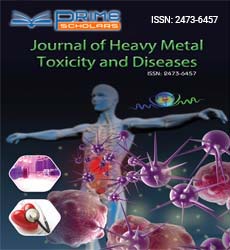Short Communication - (2024) Volume 9, Issue 2
Consumer Products and Heavy Metals: Understanding the Risks and Ensuring Safety
Xu Li*
Department of Toxicology, Zhejiang University, China
*Correspondence:
Xu Li,
Department of Toxicology, Zhejiang University,
China,
Email:
Received: 01-Apr-2024, Manuscript No. ipjhmct-24-19238;
Editor assigned: 03-Apr-2024, Pre QC No. ipjhmct-24-19238 (PQ);
Reviewed: 17-Apr-2024, QC No. ipjhmct-24-19238;
Revised: 22-Apr-2024, Manuscript No. ipjhmct-24-19238 (R);
Published:
29-Apr-2024, DOI: 10.21767/2473-6457.24.2.11
Introduction
Consumer products play an integral role in our daily lives,
providing convenience, comfort, and enjoyment. However,
many consumer goods contain heavy metals, which can pose
significant health risks if not properly regulated and managed.
Heavy metals such as lead, mercury, cadmium, and arsenic can
be found in various items, including electronics, toys, cosmetics,
and household appliances. This article explores the presence of
heavy metals in consumer products, the associated health risks,
regulatory measures, and strategies to ensure consumer safety.
Description
Heavy metals are often incorporated into consumer products for
their functional properties or as additives during manufacturing
processes. For example, lead may be used in electronics for
soldering purposes, while mercury is commonly found in
fluorescent light bulbs and batteries. Cadmium can be present
in pigments used in plastics, ceramics, and paints, while arsenic
is used in wood preservatives and pesticides. Additionally, heavy
metals may contaminate consumer products as impurities during
production or through environmental pollution during the
product’s lifecycle. Exposure to heavy metals through consumer
products can have serious health consequences, particularly
for vulnerable populations such as children, pregnant women,
and the elderly. Lead exposure, for instance, is known to impair
neurological development in children, leading to learning
disabilities, behavioural problems, and reduced IQ. Mercury
exposure can cause damage to the central nervous system,
kidneys, and reproductive organs, while cadmium exposure
has been linked to kidney damage, bone loss, and lung cancer.
Arsenic exposure is associated with an increased risk of skin, lung,
bladder, and liver cancer. To protect consumers from the health
risks associated with heavy metals, regulatory agencies around
the world have established safety standards and limits for their
presence in consumer products. For example, the Consumer
Product Safety Improvement Act (CPSIA) in the United States
regulates the levels of lead and phthalates in children’s products,
while the Restriction of Hazardous Substances (RoHS) directive in
the European Union restricts the use of certain heavy metals in
electronics and electrical equipment. Additionally, organizations
such as the International Organization for Standardization (ISO)
develop guidelines for testing and certification of consumer
products to ensure compliance with safety standards. Despite
regulatory measures, concerns remain regarding the presence
of heavy metals in consumer products, particularly in imported
goods from regions with less stringent regulations. To ensure
consumer safety, manufacturers, retailers, and regulatory
agencies must collaborate to implement robust quality control
measures and supply chain management practices. This includes
conducting regular testing and inspection of raw materials,
intermediate products, and finished goods for heavy metal
contamination. Furthermore, public awareness campaigns and
consumer education efforts can empower individuals to make
informed choices and avoid products with known health risks [1-
4].
Conclusion
Heavy metals pose a significant health risk when present in
consumer products, highlighting the importance of stringent
regulation, testing, and monitoring throughout the product
lifecycle. By adhering to safety standards and implementing
quality control measures, manufacturers can minimize the risk
of heavy metal contamination and ensure consumer safety.
Additionally, consumers play a crucial role in advocating for
product safety, demanding transparency from manufacturers,
and making informed purchasing decisions. Ultimately, a
concerted effort from all stakeholders is necessary to address
the risks associated with heavy metals in consumer products and
safeguard public health.
Acknowledgement
None.
Conflict Of Interest
The author states there is no conflict of interest.
References
- Zhang P, Cui Y, Zhang Y, Jia J, Wang X (2016) Changes in soil physical and chemical properties following surface mining and reclamation, soil physics and hydrology. Soil Sci Soc Am J. 80(6):1476-1485.
[Crossref] [Google Scholar]
- Feris K, Ramsey P, Frazar C, Moore JN, Gannon JE (2003) Differences in hyporheic zone microbial community structure along a heavy-metal contamination gradient. Appl Environ Microbiol J. 69(9):5563-5573.
[Crossref] [Google Scholar]
- Schmidt T, Schlegel HG (1994) Combined nickel-cobalt-cadmium resistance encoded by the ncc locus of alcaligenes xylosoxidans 31A. J Bacteriol. 176(22):7045-7054.
[Crossref] [Google Scholar]
- Sevgi E, Coral G, Gizir A, Sangun M (2010) Investigation of heavy metal resistance in some bacterial strains isolated from industrial soils. Turkish J Biol. 34(4):423-431.
[Crossref] [Google Scholar]
Citation: Li X (2024) Consumer Products and Heavy Metals: Understanding the Risks and Ensuring Safety. J Heavy Met Toxicity Dis. 09:11.
Copyright: © 2024 Li X. This is an open-access article distributed under the terms of the Creative Commons Attribution License, which permits unrestricted use, distribution, and reproduction in any medium, provided the original author and source are credited.

